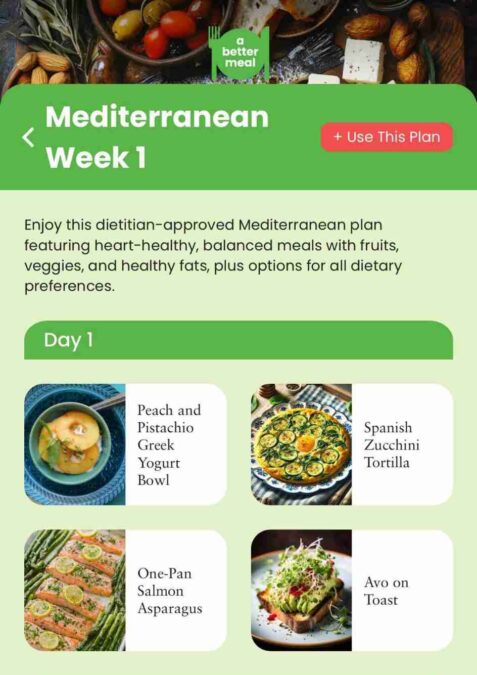Whether you’re a busy mom looking to bring more variety and healthy options to the dinner table or simply looking to add healthy variety to your diet, a Mediterranean meal plan might be just what you need. Known for its focus on fresh vegetables, lean proteins, whole grains, and healthy fats, the Mediterranean diet is not only delicious but also simple and satisfying. This beginner’s guide will help you understand how to incorporate Mediterranean-inspired meals into your week with easy, family-friendly recipes that everyone will love. Let’s dive into how to create a Mediterranean meal plan that brings fresh new flavors to your kitchen.
What is a Mediterranean meal plan?
A Mediterranean meal plan is all about embracing the foods commonly eaten in countries bordering the Mediterranean Sea, such as Greece, Italy, Spain, and Southern France. The Mediterranean diet has long been associated with a variety of health benefits, including heart health, weight management, and better digestion. The key here is balance—meals that are satisfying, flavorful, and nourishing without feeling overly restrictive. In this blog post, we’ll walk you through what foods the Mediterranean diet includes, how to easily and successfully incorporate Mediterranean flavors into healthy meal planning, and provide a sample meal plan and recipes.
How to create a Mediterranean meal plan?
Creating a Mediterranean meal plan starts with stocking your kitchen with the right ingredients. These will give you the key components of delicious Mediterranean meals, making it easy to plan and cook with the flavors of the Mediterranean.
- Stock up on fresh vegetables. Vegetables are the backbone of the Mediterranean diet. They are used in salads, soups, stews, roasted dishes, and as sides. When creating a Mediterranean meal plan, make sure to include a wide variety of fresh vegetables. Leafy greens (spinach, kale, arugula), tomatoes, cucumbers, eggplant, zucchini, and bell peppers are all staples. Use them in raw salads, cooked in stews, or roasted with herbs for a flavorful and nutrient-packed addition to every meal.
- Choose whole grains. The Mediterranean diet emphasizes whole grains as a key source of fiber, vitamins, and minerals. Foods like brown rice, quinoa, farro, bulgur, and whole-wheat pasta are commonly used. Whole grains can be incorporated into salads, used as a side dish, or mixed into soups and stews. Plan to have these grains on hand for easy, versatile meals.
- Incorporate legumes and beans. Legumes such as chickpeas, lentils, and black beans are rich in plant-based protein and fiber, making them perfect for the Mediterranean diet. Use them in salads (like a chickpea salad with cucumbers and feta), soups (lentil soup is a classic), or in veggie burgers (lentil-based patties). These nutrient-dense foods provide a satisfying, low-cost protein option.
- Choose healthy fats like olive oil. Olive oil is the cornerstone of Mediterranean cooking. Not only is it a healthy fat, but it also adds rich flavor to dishes. Use olive oil for sautéing vegetables, drizzling over salads, or for making homemade dressings. Olive oil is also perfect for roasting vegetables or grilling fish. When creating a Mediterranean meal plan, make sure that olive oil is your primary fat source, and avoid using highly processed oils.
- Plan for moderate amounts of fish and seafood. Fish and seafood are integral parts of the Mediterranean diet, offering lean protein and omega-3 fatty acids, which are good for heart health. Plan to include fish like salmon, sardines, tuna, and mackerel at least two or three times a week. You can prepare fish by grilling, baking, or cooking it en papillote (in parchment paper) for an easy, healthy meal.
- Limit red meat consumption. In the Mediterranean diet, red meat is consumed sparingly. Instead, the focus is on lean protein sources like poultry, fish, and plant-based proteins like legumes and tofu. When you do incorporate meat, go for lean cuts like chicken or turkey. Red meats, such as lamb or beef, are typically reserved for special occasions or small portions in a dish.
- Use dairy in moderation. Mediterranean diets often include dairy products, especially cheese and yogurt, but they are consumed in moderation. Greek yogurt and feta cheese are the most commonly used dairy products. Greek yogurt, in particular, is a good source of protein and can be eaten for breakfast or as a snack. Feta cheese can be sprinkled over salads, mixed into dips, or used as a topping for roasted vegetables.
What Foods Are in a Typical Mediterranean Meal Plan?
The Mediterranean meal plan revolves around fresh, whole foods that are nutrient-dense and full of flavor. Here’s a deeper dive into the specific foods included in a typical Mediterranean meal plan.
Fresh vegetables are central to Mediterranean meals. They are used in salads, roasted dishes, soups, and sides. Some of the most commonly eaten vegetables include:
- Leafy greens: Spinach, kale, arugula, and romaine lettuce.
- Tomatoes and cucumbers: Frequently used together in salads (like Greek salad).
- Zucchini and eggplant: Often used in Mediterranean stews or grilled as side dishes.
- Bell peppers, onions, and garlic: These are staples in many Mediterranean recipes, adding depth of flavor.
Fruits are enjoyed both fresh and dried in the Mediterranean diet. They are eaten as snacks, added to salads, or served with meals.
- Citrus fruits: Oranges, lemons, and grapefruits are commonly used to add a zesty flavor to dishes.
- Berries: Blueberries, strawberries, and raspberries provide antioxidants and are often added to yogurt or eaten as snacks.
- Apples, pears, and figs: These fruits provide natural sweetness and are great for snacking or adding to salads.
- Grapes and pomegranates: Popular in Mediterranean regions, grapes are enjoyed fresh or dried (as raisins), and pomegranates are often used for their tangy seeds in salads or as garnishes.
Olive oil is the primary fat used in Mediterranean cooking. Olive oil is used for cooking, drizzling over salads, or making dressings. It’s rich in monounsaturated fats, which are heart-healthy. But you can also get healthy oils from nuts and seeds like almonds, walnuts, and pistachios are common snacks or ingredients in Mediterranean dishes. They’re high in healthy fats and protein.
A variety of whole grains provide fiber and essential nutrients.
- Brown rice, quinoa, and farro: These are excellent side dishes and can be added to salads or stews for extra bulk and nutrition.
- Whole wheat pasta: Pasta is a staple in Mediterranean cooking, it’s used in a variety of pasta dishes, often paired with fresh vegetables and lean proteins. Choose whole wheat pasta to make it another source of whole grains.
- Bulgur wheat: Used in dishes like tabbouleh, bulgur is high in fiber and has a light, nutty flavor.
Legumes are an important plant-based protein source in the Mediterranean diet:
- Chickpeas: Used in hummus, salads, or soups like the classic Mediterranean chickpea stew.
- Lentils: Great in soups, stews, or veggie burgers. Lentils are packed with protein and fiber.
- Black beans and kidney beans: Often used in Mediterranean bean salads, stews, and veggie-based dishes.
Since Mediterranean countries border the sea, fish is both plentiful and popular as a component of the Mediterranean diet — with fatty fish an important source of omega-3 fatty acids.
- Salmon, sardines, and mackerel: These fatty fish are high in heart-healthy fats and provide protein for the Mediterranean diet.
- Tuna and shellfish: Tuna is commonly used in Mediterranean salads or pastas, while shellfish is often featured in stews or grilled dishes.
Dairy products add flavor and texture with thick, tangy Greek yogurt a staple in Mediterranean breakfasts or snacks. It’s creamy, protein-packed, and often topped with honey, nuts, or fruit. Cheese can be added as well. From briny feta to the rich flavor of parmesan, Mediterranean cheeses are used in salads, on roasted vegetables, part of dips, and as a topping for pasta and more.
It wouldn’t be a Mediterranean meal without the zest of fresh herbs and spices — an essential flavoring for dishes throughout the Mediterranean. Commonly used herbs include:
- Basil, oregano, and rosemary: These herbs are used in both savory dishes and Mediterranean sauces.
- Garlic and onions: These add aromatic flavor to almost every meal.
- Cumin, paprika, and coriander: Common spices used in stews, dips, and grilled dishes.
With these foods as the foundation of your Mediterranean meal plan, you can create a wide variety of flavorful, nutritious meals for the whole family. The Mediterranean diet isn’t just about specific foods; it’s a lifestyle that focuses on eating fresh, seasonal, and balanced meals that promote overall health and enjoyment of food.
What is an example of a Mediterranean meal plan?
Here’s an example of what might be included in a one-day Mediterranean meal plan:

By subscribing to A Better Meal, you can get specially curated, free Mediterranean meal plans, making it a snap to add healthy new Mediterranean-style ingredients and meals to your family’s diet.
Sample Mediterranean Meal Plan Recipes
A Better Meal has a wealth of Mediterranean recipes, designed to make it simple to add the fresh flavors of the Mediterranean to your diet. Who doesn’t love pizza — it’s always a family favorite. Try our Roasted Peppers, Spinach and Feta Pizza. Now, your family can enjoy pizza — and you’ll get the peace of mind that they’re also getting added veggies and greens. Or make our Lentil Veggie Burgers for a healthier burger night. Need a quick and easy meal? Try our Salmon and Vegetables en Papillote — using an easy technique to wrap the fish and veggies in parchment paper, letting them steam and infuse with flavor in minutes.
Easy Mediterranean meal plan — A Better Meal can help
When you’re a busy mom, time is precious. The key to sticking with a Mediterranean meal plan is to keep things simple. Meal planning apps like A Better Meal simplify the process of planning and preparing meals dramatically. As I mentioned before, A Better Meal provides curated meal plans tailored to busy family life, providing variety and inspiration without extra effort.
Whether you are looking for a 1 week Mediterranean meal plan or simply want to make planning healthy meals less stressful, A Better Meal makes meal planning easier in many ways with features that our users love and rely on every day! Here are some highlights:
- Automatic Meal Planning. With 5,000+ recipes and adding more all the time, you’ll never get stuck in a rut. A Better meal generates your meal plans instantly — based on your preferences and dietary needs.
- Recipe Import and Favorites. Keep all your recipes in one place. You can easily import recipes that you see online or on social media, so they’ll be at your fingertips when you need them. What’s more, you can add recipes that you love to your favorites, for quick and easy access anytime.
- Instant Grocery Lists. Creating a grocery list doesn’t have to take forever. Turn your meal plan into a grocery list instantly and share with whoever needs to go shopping. You can even upload to your favorite stores or shopping apps — Walmart, Kroger, Instacart, and more!
Your journey to the Mediterranean has just begun. You’ll love adding new recipes and flavors to the family table, knowing that your adding health benefits too. And, if you’d like to try A Better Meal, you can download the app for free here.

